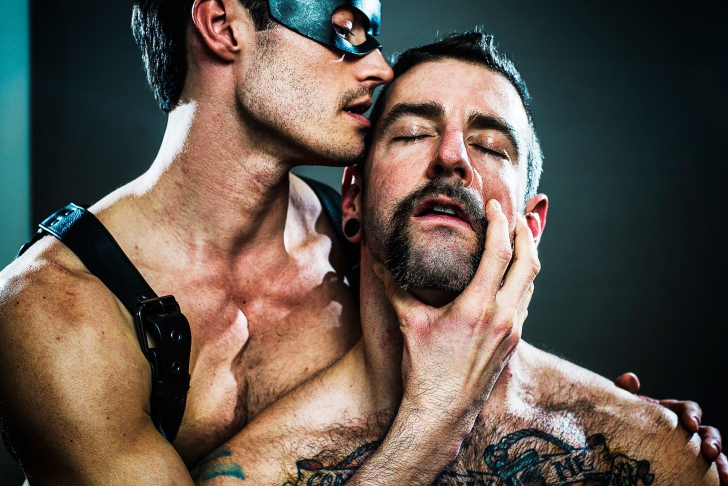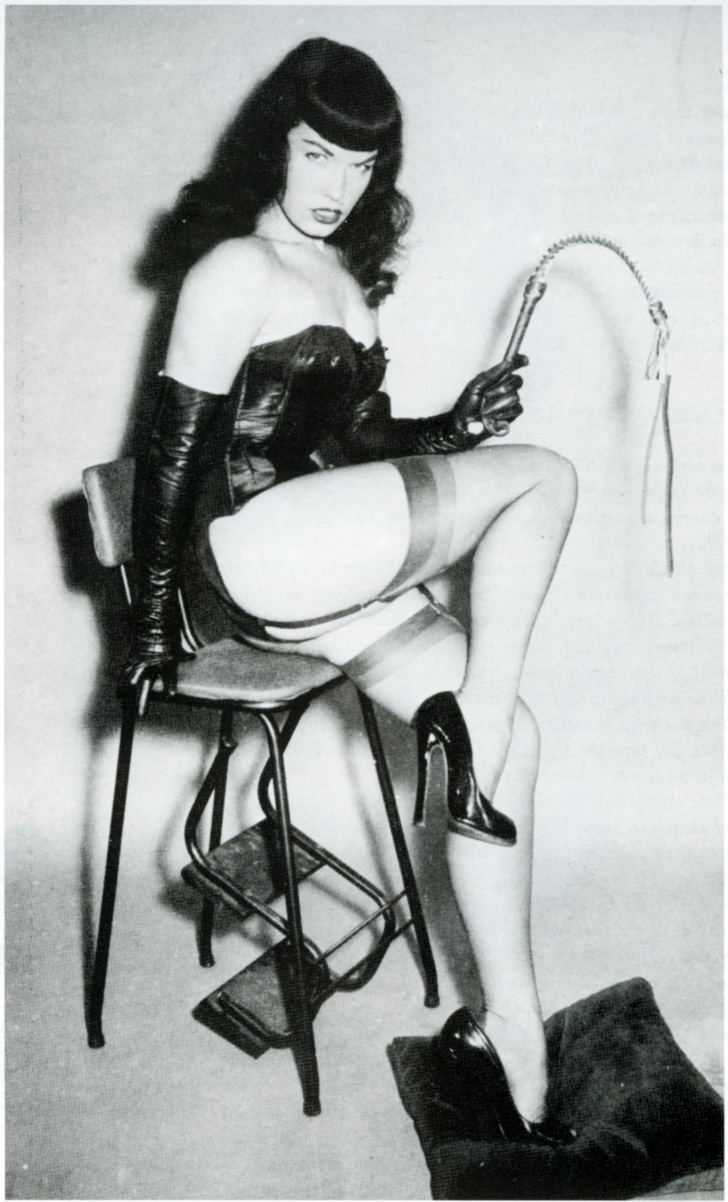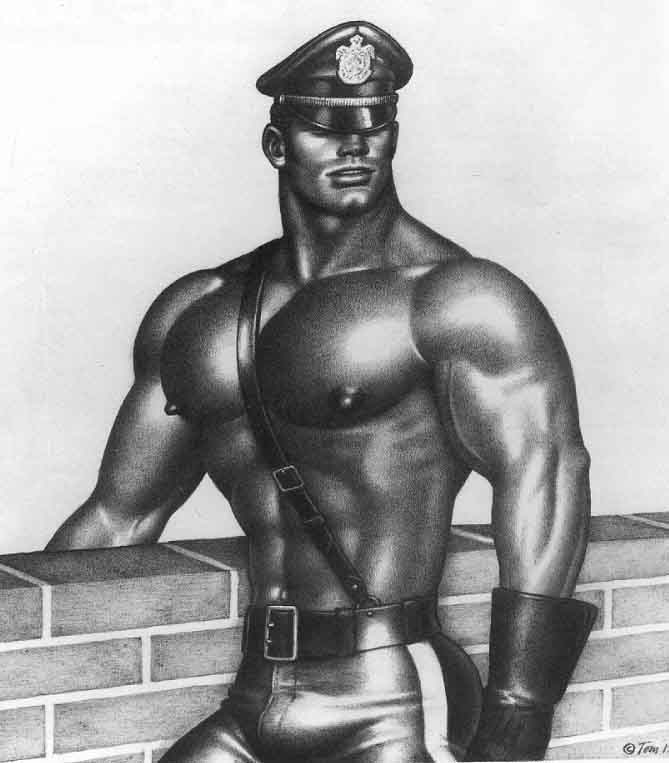
Master Tony leads me down a darkened hallway in his apartment, stopping before a single door.
“Would you like to see my playroom?”
We enter what was once a bedroom, but that has now been transformed into something very different. A leather sling hangs from the ceiling before a closet filled with various types of leather fetish gear. Erotic artwork and posters hang on the charcoal-grey walls, surrounded by shelves lined with dildos and buttplugs of various sizes. In the corner is an antique examining table, and beside it are a series of medical trays, plastic collection containers and metal briefcases containing electro-stimulation equipment.
Tony, International LeatherSir 2009 and a representative of the Rough House BDSM dungeon parties, has clearly put work into the space. I marvel at the quantity of items in the room, offhandedly describing it as a veritable museum of erotic play.
“Well, I’ve been collecting for a long time,” he says, proudly.
A long time, indeed. To explore the roots of BDSM culture is to interrogate the fundamental dynamics of human interaction. Dominance and submission, restraint and role-play have been present in both erotic and non-erotic practices throughout much of recorded history and across different cultures, with examples of it in some of humanity’s earliest texts. Flagellation was regularly performed as part of religious ritual in ancient Sparta, for instance, and evidence of physical aggression in erotic play dates back to the sixth century BCE and is referenced in both Petronius’s Satyricon and the Kama Sutra.
And according to professional dominant and BDSM educator Scarlet Riot, consenting to restrictive or controlled experiences has always provided significant emotional relief to people who led otherwise stressful lives and were subject to strict socioeconomic divisions.
“Giving in to some type of physical anguish has been an important element of many antique and modern faith systems — passion plays, fasting, adolescent rites of passage,” Riot says. “And we’ve [also] seen this in the ways people challenged the stigmas attached to certain sexual practices throughout history.”
French philosopher the Marquis de Sade, whose 18th-century libertine politics and sexual practices drew the ire of the Catholic Church, wrote extensively of sex acts that often incorporated violence and blasphemy. His “sadistic” works, along with Leopold von Sacher-Masoch’s Venus in Furs, heavily influenced much of the power-associated erotic practices that would be referenced in Victorian literature.

Scholars trace modern BDSM to a few key sources in the 20th century. The sexual progressiveness of pre–Second World War Weimar Germany was an extension of a European fetish culture that had been in play the first few decades of the 1900s, while a distinctive heterosexual kink culture rose up in the United States during the Depression Era. But it was after the Second World War that things really started to take shape, with the birth of the leather community and the beginnings of a gay subculture.
“That war was romanticized,” Master Tony says. “And it was romanticized by the people who were actually fighting in the war. Men who had gone overseas had camaraderie and a fraternity, and they loved each other — not in a sexual sense, but in that they looked out for each other.”
“And a lot of men, when they came back, couldn’t go back to their old lifestyle simply because they enjoyed the hierarchy of things. Some men appreciated having a superior officer or someone who would clean their boots and that kind of thing. Things blossomed from that, and the gay men within the community eventually branched out on their own, founding bike and leather clubs.”

It was also around this time that the subculture started to enter the mainstream through the work of photographer Irving Klaw, whose damsel-in-distress pin-up photographs featuring model Bettie Page were quite popular.
“In the Western world, BDSM started making an appearance outside of counterculture in the 1940s, with Page’s erotic photos making the rounds with elements of bondage and restraint,” Riot says. “The reserved sexual attitudes of the time did not inhibit the interests of the kinksters, as is evident by the countless fetish-oriented magazine titles published at the time.”
“When pin-up girls and posters like that started happening, I think that’s when things changed,” Master Tony says. “People were looking at things more sexually than they had prior to that. Look at the work of Russ Meyer. I mean, the women in his films looked like they were cinched up in corsets, and their breasts were huge and pushed out. And, of course, look at Marlon Brando in The Wild One.”
Meanwhile, underground leather culture thrived in many major cities where gay communities had sprung up after the war, including New York and San Francisco. Mr Leather and Mr Drummer contests were established early on, and magazines like Physique Pictorial popularized images of the male form that were overtly homoerotic.
“It ran under the radar of pornography because it had men posing in thongs, but they were doing things that were incredibly masculine,” Master Tony says. “There was wrestling. There was roughhousing. Guys on bikes, that kind of thing.”
The magazine also ran artwork by Tom of Finland. The artist had served during the Second World War, and his time fighting alongside German soldiers in Russia inspired much of his artwork, which fetishized men in uniform.

“A lot of Tom of Finland’s stuff has actual Nazi photographs that he’s touched up to be sexualized,” Master Tony says. “So their cock would be hanging out, that kind of thing. And romanticizing the britches, the boots, the uniform and that hyper-masculine image. There’s something more exhilarating about that than seeing people cuddling in bed.”

With the shifting social mores of the 1960s and ’70s came more extreme forms of sadomasochistic sexual behaviour within the underground leather community, as described in Larry Townsend’s Leatherman’s Handbook and depicted in the photos of Robert Mapplethorpe. The culture developed enough of a reputation to inspire the 1970 crime novel Cruising, about a serial killer stalking gay men on the leather scene. The book was famously adapted into the 1980 thriller starring Al Pacino.

The 1980s and ’90s saw BDSM culture shift even more into the mainstream, with musical artists like the Eurythmics and Madonna employing fetish imagery and themes in their works and mainstream films like 9½ Weeks, Body of Evidence and Exit to Eden portraying BDSM erotic practices.
“BDSM has also made many appearances in mainstream film and television, on episodes of CSI, films like 9½ Weeks and Secretary, and has been explored by Oprah and on Dr Phil,” Riot says. “My mother even made a reference to ‘SNM’ in a Facebook status recently commenting on the Jian Ghomeshi affair, which really brought my belief that it’s time we start having open conversations about BDSM.”
The internet also introduced kink culture to a much wider audience, causing the community to evolve beyond its more underground, niche-driven roots.
“The fetish community has started to open up and spread out, and so there are so many things that are now identifying as part of the BDSM community,” Master Tony says. “Things that are not bondage or discipline or sadomasochism still fall under the umbrella, so it can be almost any fetish at this point. But who is to say what should or shouldn’t fall under that umbrella?”
Riot agrees. “It’s used as a bit of a catchall for a community that includes fetishists, lifestylers, those who explore BDSM acts as art or cultural critique, and those who casually incorporate elements of power into their otherwise normative sex lives. [But] the community has grown out of like-minded people interested in helping each other create the illusions that speak to their fantasies.”
So how does one define BDSM today?
“Kinky people are a lot like everyone else,” Riot says. “Most of the couples I know have the same arguments and relationship strife that non-kinky people do. It’s just that instead of resolving those issues with a romantic dinner and roses, they may opt for a spanking and blowjob instead. Both experiences incite joy and comfort in people, so who are we to limit that exploration if it’s being done in a safe and consensual way?”

 Why you can trust Xtra
Why you can trust Xtra


